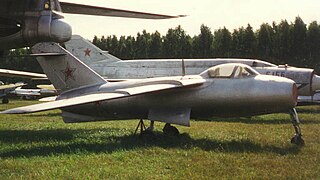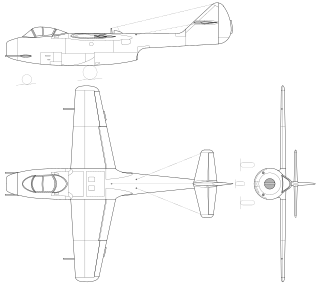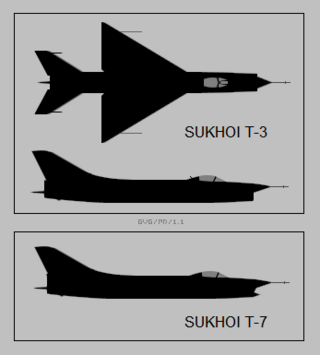
The Yakovlev Yak-36, also known as Izdeliye V, is a Soviet technology demonstrator for a VTOL combat aircraft.

The Lavochkin La-15, was an early Soviet jet fighter and a contemporary of the Mikoyan-Gurevich MiG-15.

The Yakovlev Yak-15 was a first-generation Soviet turbojet fighter developed by the Yakovlev design bureau (OKB) immediately after World War II. The main fuselage was that of Yakovlev Yak-3 piston-engine fighter modified to mount a reverse-engineered German Junkers Jumo 004 engine. The Yak-15 and the Swedish Saab 21R were the only two jets to be successfully converted from piston-power to enter production. 280 aircraft were built in 1947. Although nominally a fighter, it was mainly used to qualify piston-engine-experienced pilots to fly jets.

The Yakovlev Yak-19 was a prototype Soviet fighter built in late 1940s. It was the first Soviet aircraft to be equipped with an afterburning turbojet, the Klimov RD-10F that was derived from the German Jumo 004 engine. Only two examples were built as it was rejected for service by the Soviet Air Force.
The Yakovlev Yak-25 was a Soviet military aircraft, an early turbojet-powered fighter aircraft designed by the Yakovlev OKB. The designation was later reused for a different interceptor design. Tasked by the Council of Ministers in a directive issued on 11 March 1947, with producing a straight winged fighter similar to the earlier Yak-19, but powered by a Rolls-Royce Derwent V, OKB-115 swiftly produced the Yak-25, which blazed several trails as the first Soviet fighter with a fully pressurised cockpit, air conditioning, jettisonable canopy, and hydraulic airbrakes on the fuselage amongst other innovations.

The Lavochkin La-150, was designed by the Lavochkin design bureau (OKB) in response to a 1945 order to build a single-seat jet fighter using a single German turbojet. By this time both the Americans and British, as well as the Germans, had already flown jet fighters and the single Soviet jet engine under development was not yet ready for production. The design was completed quickly, but the construction of the five flying prototypes was protracted by the factory's inexperience in building metal aircraft. The aircraft made its first flight in September 1946, but proved to require extensive modifications to meet the Soviet Air Forces' requirements. These took so long to make and test that the aircraft was essentially obsolete by the time that they were completed. Even one variant with a much more powerful engine was inferior to other aircraft that the OKB had under development and all work was terminated in 1947.

The Yakovlev Yak-30 was an experimental Soviet interceptor from the late 1940s. Derived from the Yak-25, from which it differed primarily in having wings sweptback 35° at quarter chord, the Yak-30 retained the fuselage, tail surfaces and undercarriage of the earlier fighter.

The Sukhoi T-3 was a prototype Soviet fighter aircraft.
The Ilyushin Il-46 was a jet-engined bomber produced in the USSR during 1951-2, as the result of a directive to redesign the Il-42 project. The revised specification was for an aircraft with twice the range and 1 1/2 times the bomb load, with a prototype ready to be submitted for state acceptance trials in July 1952. The Ilyushin design bureau set about designing two versions of the same aircraft, the straight-wing (Il-46) and the swept-wing (Il-46S), with as much as possible common to both aircraft. To meet the schedule for state acceptance trials Ilyushin built only the straight-wing version, fearing that the design, manufacture and flying characteristics of the swept-wing aircraft might cause delays.

The Lavochkin La-152,, and its variants, was a jet fighter prototype designed and manufactured by the Lavochkin Design Bureau (OKB) shortly after the end of World War II. Derived from the Lavochkin La-150, the 152 used several different engines, but the program was canceled as other fighters with more powerful engines and swept wings showed more promise.
The Lavochkin La-168 was a jet fighter developed for the USSR. Like the better known Mikoyan MiG-15 which was ultimately selected and went on to become one of the most successful jet fighters of its era, the Lavochkin La-168 was designed in response to a 1946 request for an advanced swept-wing jet fighter capable of transonic performance. It was to use new turbojet based on the Rolls-Royce Nene in competition with the design bureaus of Artem Mikoyan and Mikhail Gurevich, and Aleksandr Yakovlev. A scaled down version of this aircraft would lead to the production of the La-15, which performed well but would be dropped in favor of the MiG-15.
The Lavochkin La-190,, was a swept wing jet fighter designed and manufactured by the Lavochkin Design Bureau from 1950.

The Lavochkin La-200 was a two-seater, swept winged, night/all-weather jet prototype designed as an interceptor and manufactured by the Soviet Union's Lavochkin Design Bureau from 1948.
The Alekseyev I-21 was a Soviet twin-engined jet fighter, built in the late 1940s. Two prototypes were constructed with the designation of I-211, of which one was converted into the I-215 with more powerful engines. A third aircraft was built to evaluate the bicycle landing gear arrangement for use in other aircraft. The fighter was not accepted for production as it was inferior to the swept-wing fighters like the Mikoyan-Gurevich MiG-15.

The OKB-1 150 was a jet bomber designed and produced in the Soviet Union from 1948.
The I-218 was an attack aircraft designed and built in the USSR from 1947.
This is a glossary of acronyms and initials used for miscellaneous items, materials and nicknames in the Russian Federation and formerly the USSR. The Latin-alphabet names are phonetic representations of the Cyrillic originals, and variations are inevitable.
This is a Glossary of acronyms used for aircraft designations in the Russian Federation and formerly the USSR. The Latin-alphabet names are phonetic representations of the Cyrillic originals, and variations are inevitable.
The Mikoyan-Gurevich I-75 was the final design of a series of three experimental swept-wing interceptors developed in the Soviet Union in the mid-late 1950s by the Mikoyan-Gurevich design bureau from their Mikoyan-Gurevich I-3 airframe. All the aircraft in the I-3 program were affected by delays in the development of the Klimov VK-3 turbojet engine, its cancellation and ultimate replacement by the Lyulka AL-7F turbojet engine.

The Mikoyan-Gurevich Ye-150 family was a series of prototype interceptor aircraft designed and built by the Mikoyan-Gurevich design bureau in the Soviet Union from 1955.











